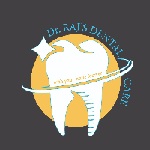Periodontist is a doctor of gums and for the treatment, it may involve gum surgery. The periodontal surgery can repair damaged bones, prevent tooth loss, reduce gum gaps between teeth, eliminate bacterial growth in the jawbone, and treat gum disease.
The treatment involves non-surgical procedures such as:
- Dental cleaning: It removes plaque from all surfaces of the teeth, the dentist will remove tartar (plaque that builds up on the tooth surface and can only be removed by professional cleaning) from above and below the gum line. This may be referred to as scaling procedure that involves a laser or ultrasonic instrument.
- Root planing: The root planing procedure smoothes root surfaces to discourage further buildup of tartar and bacteria, and removes bacterial byproducts that contribute to inflammation and ensures that the gums reattach to the teeth on a clean surface.
In periodontal flap surgery, the gums are lifted back and the tartar is removed. Damaged bones may have irregular surfaces that are smoothed to limit the areas in which disease-causing bacteria can hide. Afterwards, the gum tissue is fitted tightly around the tooth. By reducing the space between the gum and the tooth, the occurrence of periodontal disease can be lessened. This method decreases the growth of harmful bacteria and reduces the risk of serious health problems.
Bone grafting is the replacement of the bone destroyed by gum disease is performed using fragments of your own bone, synthetic bone, or donated bone. A dental graft serves to aid in the regrowth of bone, which in turn restores stability to teeth.
The removal of wisdom tooth through surgical procedure is known as disimpaction. This surgery may be recommended by your dentist if an exam and X-rays indicate that your wisdom teeth are impacted and need treatment. As decided by the dentist with the consent of the patient, Disimpaction is initiated with administration of local or general anesthesia.
Jaw cysts are growths that develop slowly and typically appear only on X-rays or scans during a dental appointment. Sometimes, they can become infected and painful or can threaten neighboring teeth and therefore need to be removed. The treatment depends on the type of injury, the stage of the injury and their symptoms. Surgical treatment is generally required for jaw tumors and cysts. There are some cases where medical therapy and surgery are combined as a form of treatment.
Firstly, to ease out swelling some pain relieving drugs are prescribed and antibiotics too for infection, if any. The type of treatment is determined by the location and extent of the injury. A facial fracture is treated to restore the normal appearance and function of the injured area. Depending upon the severity of the fracture, a closed reduction can be performed (resetting the bone or bones without surgery) or an open reduction (an incision to reposition the broken bones). A complex fracture involving multiple broken bones will require reconstructive surgery.
The temporomandibular joint is a hinge connecting jaw to the temporal bones of the skull, located in front of each ear. TMJ disorders, also known as Temporomandibular Joint Disease (TMD), affect the jaw joints and the associated ligaments or muscles. This might be caused as a result of an improper bite or the regular wear and tear. The most common symptoms include tenderness in the jaw, ear-aches, headaches, and facial pain.
According to the patient’s condition, there are different types of treatment such as:
- Medications: Some pain relievers and anti: inflammatory is prescribed to reduce the pain for a limited time. If there is a muscle spasm, the dentist may prescribe muscle relaxants.
- Oral splints or mouth guards: Mouthpieces worn over the upper or lower teeth are called splints and night guards. By wearing them, they ensure that your teeth feel stable as they close. Mouth guards are also effective in correcting your bite by positioning your jaw in a more suitable position when worn. Splints are basically full-time wear compared to night guards, which are worn at night only.
- Surgical: There are three types of surgical procedures:
- Arthrocentesis: This minimally invasive procedure uses small needles to irrigate fluid through the joint to remove debris and inflammatory products.
- Arthroscopy: The procedure begins with the insertion of a thin tube (cannula) into the joint space, followed by an arthroscope and small surgical instruments. TMJ arthroscopy has fewer risks and complications.
- Open-joint surgery (arthrotomy): This may be recommended if your jaw pain does not resolve with more conservative treatments and appears to be caused by a structural problem in the joint.
